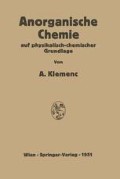Zusammenfassung
Diese drei Metalle haben je zwei Wertigkeiten, die beim Silber am schwächsten betont sind, da dieses fast ausschließlich I-wertig ist. In allen Oxydationsstufen bilden sie beständige Komplexverbindungen, in den höchsten Stufen mit der Koordinationszahl vier. Während Kupfer- und Goldverbindungen gefärbte Lösungen geben, sind die des Silbers farblos. Ihre Stellung in der Spannungsreihe kennzeichnet sie, besonders das Silber und Gold, als Edelmetalle.
Access this chapter
Tax calculation will be finalised at checkout
Purchases are for personal use only
Preview
Unable to display preview. Download preview PDF.
Author information
Authors and Affiliations
Rights and permissions
Copyright information
© 1951 Springer-Verlag in Vienna
About this chapter
Cite this chapter
Klemenc, A. (1951). Kupfer, Silber, Gold. In: Anorganische Chemie auf physikalisch-chemischer Grundlage. Springer, Vienna. https://doi.org/10.1007/978-3-7091-7793-8_48
Download citation
DOI: https://doi.org/10.1007/978-3-7091-7793-8_48
Publisher Name: Springer, Vienna
Print ISBN: 978-3-7091-7794-5
Online ISBN: 978-3-7091-7793-8
eBook Packages: Springer Book Archive

